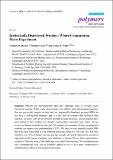Intrinsically Disordered Proteins: Where Computation Meets Experiment
Author(s)
Burger, Virginia M.; Gurry, Thomas; Stultz, Collin M.
DownloadBurger-2014-Intrinsically Disord.pdf (4.669Mb)
PUBLISHER_CC
Publisher with Creative Commons License
Creative Commons Attribution
Terms of use
Metadata
Show full item recordAbstract
Proteins are heteropolymers that play important roles in virtually every biological reaction. While many proteins have well-defined three-dimensional structures that are inextricably coupled to their function, intrinsically disordered proteins (IDPs) do not have a well-defined structure, and it is this lack of structure that facilitates their function. As many IDPs are involved in essential cellular processes, various diseases have been linked to their malfunction, thereby making them important drug targets. In this review we discuss methods for studying IDPs and provide examples of how computational methods can improve our understanding of IDPs. We focus on two intensely studied IDPs that have been implicated in very different pathologic pathways. The first, p53, has been linked to over 50% of human cancers, and the second, Amyloid-β (Aβ), forms neurotoxic aggregates in the brains of patients with Alzheimer’s disease. We use these representative proteins to illustrate some of the challenges associated with studying IDPs and demonstrate how computational tools can be fruitfully applied to arrive at a more comprehensive understanding of these fascinating heteropolymers.
Date issued
2014-10Department
Institute for Medical Engineering and Science; Massachusetts Institute of Technology. Computational and Systems Biology Program; Massachusetts Institute of Technology. Department of Electrical Engineering and Computer Science; Massachusetts Institute of Technology. Research Laboratory of ElectronicsJournal
Polymers
Publisher
MDPI AG
Citation
Burger, Virginia M., Thomas Gurry, and Collin M. Stultz. “Intrinsically Disordered Proteins: Where Computation Meets Experiment.” Polymers 6, no. 10 (October 2014): 2684–2719.
Version: Final published version
ISSN
2073-4360